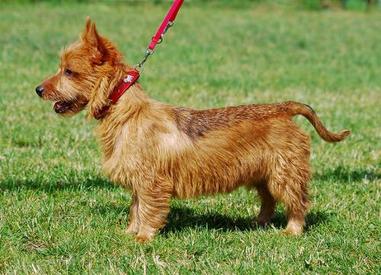
This article also relates to: Australian Silky Terrier
Both the Australian Terrier and the Australian Silky Terrier came into existence in the early 19th century and are the result of selective crossing between several native British terriers, including the Cairn Terrier, Norwich Terrier and Yorkshire Terrier. Many believe that the Australian Terrier of old was developed from the rough-coated Terrier that emigrated alongside British colonists to Tasmania. First observed in Melbourne, Australia in 1868, the two breeds gained popularity as versatile working and companion dogs, utilised in catching and killing vermin and snakes, and becoming popular in Britain in 1936.
One of the smallest working Terrier breeds, the Australian Terrier and Silky Terrier are often classified under the 'toy' branch of canines due to their low to the ground stature. The Australian Terrier is characterised by a compact build, short legs, small almond-shaped eyes, a deep chest, high-set ears and tail. The difference between the two Terrier breeds is coat-related, with the coat being slightly longer on the Silky Terrier. The coat is commonly observed in colour variations of blue, silver, white, tan, sand and grey. Whilst still being used to hunt vermin about the homestead, the modern Australian Terrier and Australian Silky Terrier are often seen in obedience, tracking, herding, rally, flyball and as popular therapy dogs.
Retaining their inherent hunting instincts, the breed may exhibit independent-minded and stubborn behaviours, whilst its energy and enthusiasm may translate through boisterousness and destructive behaviours in the home; it is important to show firm leadership and consistent training from puppyhood in order to manage these potential traits. Otherwise, the Australian Terrier is an adaptable and trainable breed, well suited to the relaxed domestic lifestyle. Affectionate and loyal, the breed is compatible with children when raised with them and displays natural authority and vigilance, making for the ideal watch dog. On average, a healthy Australian Terrier will weigh 4-6 kg, with a life expectancy of 12-15 years when shown the appropriate care.
Typically healthy and long-lived, with documented cases of the breed living well into its 20's, the Australian Terrier is not susceptible to any serious breed-specific or hereditary diseases. Genetic eye disorders, including progressive retinal atrophy and juvenile cataracts are identified in the breed, along with patellar luxation.
Do you own a Australian Terrier? Let others know what they're like!
Related products
Dog Gone Smart Suede Quilted Belly Coat Red
from £14.83
KONG Anxiety Reducing Shirt for Dogs
from £17.30
Hurtta Rain Blocker ECO
from £89.99
Trixie Walker Active Long Protective Boots For Dogs Black
from £21.98
Trixie Walker Active Protective Boots Black
from £15.98
Advantage 80 Spot On Flea Control Large Cats and Rabbits
from £12.95
Advantage 40 Spot On Flea Control Cats, Small Dogs and Rabbits
from £12.95
Advantage 100 Spot On Flea Control Medium Dog
from £12.95